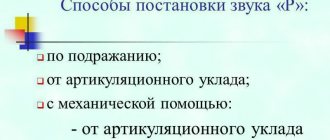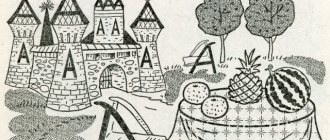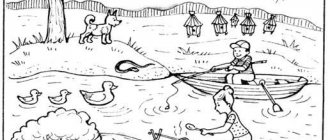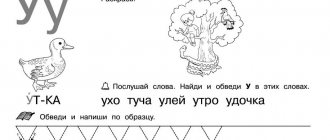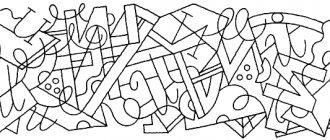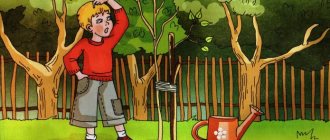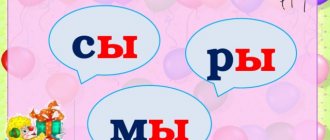Summary of OOD in the speech therapy group “Sounds [U], [A]”
Svetlana Timofeeva
Summary of OOD in the speech therapy group “Sounds [U], [A]”
Goal: formation of phonetic-phonemic perception.
1. Strengthen the pronunciation and distinction of the sounds “U”
,
"A"
.
2. Learn to pronounce the sound combinations “AU!”
,
"YAH!"
.
3. Form the prosodic side of speech: loud - quiet, long - short.
4. Develop auditory and visual attention, articulatory and fine motor skills.
Equipment: mirrors, object pictures (doll, train)
symbols
of the sounds “U”
,
“A”
, plot pictures (a girl in the forest, a baby crying, a tambourine.
On the topic: methodological developments, presentations and notes
In a playful lesson, children improve the skills of phonemic analysis and synthesis, learn to determine the place of the sound C in words, and become familiar with the letter C.
The proposed lesson is designed for children of senior preschool age with ODD. The lesson is based on visual symbols, which helps children master sound analysis and synthesis. In a playful way.
The material is recommended for a speech therapist when conducting a frontal lesson on the formation of sound pronunciation and literacy training in the senior group.
During the lesson, children consolidate the pronunciation of the sound Zh in syllables, words, phrases, get acquainted with the letter Zh, and perform interesting tasks.
Consolidating the correct pronunciation of the sound “L” in syllables, words, and connected speech.
Educational objectives. Introducing the sounds [f] and [f'], the letter Ff. Improving the skills of sound analysis and synthesis. Improving the skill of reading syllables.
Introducing the sounds [z] and [z'] and the letter Zz. Improving the skill of reading syllables, words, sentences with the new letter Zz. Improving the skills of sound and syllabic analysis and synthesis.
Sounds [s], [s']. Letter C, s. Consolidation
PREDICTED RESULTS:
• children will repeat material about the syllabic role of vowels;
• learn to distinguish between hard and soft consonant sounds and determine their location in words;
• improve skills in reading words and syllables with learned letters;
• learn to think logically and give explanations.
DURING THE CLASSES
1. Updating knowledge
- What letter did we meet in the previous lesson? Tell us everything you know about the letter s. Find the letter c on the letter strip. What new letters can appear on the same line? What letters will appear on the top line of the tape? What letters form syllables in Russian? How to find out how many syllables there are in a word?
2. Motivation for learning activities
- Read the syllable table. Make words from syllables. Find words among the syllables. Write them down in a printable notebook.
- Read the various combinations of letters and syllables on the cards. Indicate the merging syllables. Complete the syllable and get the word.
3. Work on the topic of the lesson
- Look at the picture on page 46 in the upper right corner. Make a sentence based on this drawing.
Read the sentence that the author has written for you. What's the girl's name? (Sonya.)
How many words are there in this sentence? (Three.)
How many words in the sentence are capitalized? (Two.) Why? (Girl's name. First word in a sentence.)
Name the preposition in this sentence. (U.)
What words differ by one letter? (Sleigh, Sony.)
Do these words have the same meaning? (No.)
Why? (One is the girl’s name, the second is the name of the object.) Read the sentence: Sleigh at Sanya’s. Has our offer changed? How? (The girl's name has changed.)
Why did it change? (The letter o was replaced with the letter a.)
Does the artist need to paint a new picture? (No, no need. The girl can be called Sanya.)
Changing the letter changed the name. Now let’s read the chains of syllables (p. 50). How many syllables are in the first chain? (Three.)
How many words did you notice? (Wasp, sleigh - two words.)
Is it possible to form more words from these syllables? (They.)
Let's move on to the second chain. How many syllables are in this chain? (Three.) How many words did you see? (Pump, pine.)
Is it possible to combine the syllables ni and na? Why? What needs to be changed to make a word? (Nina.)
Is it possible to form more words from these syllables?
Read the merger syllables with the letter n (p. 46). Check which syllable is missing? (Well, but.)
Read the merger syllables with the letter s. Check which syllable is missing. (Su.)
Well done! You are very attentive! Now the task is even more difficult: carefully examine the scattered syllables and letters and make words from them. (O-na, o-ni, o-si, o-sa, us, u-sy, sa-ni, son, dreams, dream, so-si, sos-na, na-sos, pumps, us, us -no, aspen...)
Read the first sentence (p. 46). Who is this sentence talking about? What does it say about Nina? In your printable notebook, outline your complete sentences.
— Circle the preposition in the diagram.
We read the proposal. (Nina!)
How should this sentence be read? Why? (You have to read it loudly, because someone is calling the girl.)
What sign helps us read this sentence expressively? (Exclamation mark.)
Read the next two sentences. (Wasps! Wasps!)
How should you read these sentences? (Loud.)
Why is the same sentence repeated twice? (Someone wants to warn the girl about the danger.)
Our artist drew a picture. Is everything correct in the picture or can something be added?
Write down block letters for dictation. Small o, capital S, small n, capital U; small a, s, s, i, capital I, U, A; capital 0. Which letter did you forget to write? (Bukvyn, N.) Point out the trap. (s)
Now I will dictate the syllables, and you write down only those that begin with a vowel sound: na, os, so, an, well, ny, ys, as, ni, in, un, si, us. Read the syllables. Which of the written syllables are words? Emphasize them. (Os, us, as, an, ys, in, un.)
Children guess the puzzles written on page 46 of the textbook, and this puzzle:
- Now write down the word I’m going to tell you about. The insect has six legs. Two pairs of transparent wings. The abdomen is striped - yellow with black and a sting. Mustache. Collects nectar. It stings very badly. Who is this? (Wasp.)
Make a diagram of this word. How many syllables are in this word? How many sounds does the first syllable have? Second syllable? Name the merging syllable in this word. Which syllable is stressed? What is the vowel in this syllable called? Which syllable will be unstressed? How is this unstressed vowel heard? Let's put it under emphasis. The rule will help us: one is many. (O'-sy.) Write this word in block letters. Check the diagram to see if you have written all the letters.
What other insects do you know? Will a spider be an insect?
Do similar work with the word aspen (p. 45). Is it possible to put stress on the first vowel? (No.) Such words must be remembered. These are dictionary words.
Look at the illustration on page 47. Can an elephant be called an insect? Why? Can this drawing be called real? Look how the artist joked. What is the elephant doing? (Reads the ABC, holds a daisy in his trunk, sits on a bench in the city, wears a hat.)
Isn’t it about this elephant that the poet Valentin Berestov wrote about? Where does this elephant live? (In Moscow. He is a Muscovite.)
How did he get to Moscow? (It was brought from another country.)
Do we have elephants? Where can you see a live elephant in Moscow or another city? (At the zoo, at the circus, at the Durov Theater...)
4. Reflection on learning activities
- What did we learn to do for the first time?
What can we already do with letters and syllables? (Check unstressed vowels. The rule “one object, many objects” helps us. We learned about the dictionary and vocabulary words that need to be remembered.)
Course of the lesson
1. ORGANIZATIONAL STAGE.
(loudly) will sit down.
.
2. CORRECTION AND DEVELOPMENT STAGE.
1. Articulation gymnastics: Once upon a time there was a Tongue. He woke up early in the morning. I opened the window (open my mouth, ventilate the room. Did gymnastics: bending to the right, left (corresponding tongue movements)
.
He closed the window (close his mouth)
and went to wash himself.
I brushed my teeth (moving my tongue from the roots to the edges of the upper teeth, then the lower teeth, rinsed my mouth (puffing out my cheeks one at a time)
. And went to prepare breakfast. Kneaded the dough
(bite intensely in the middle of the tongue)
. Baked pancakes
(bite the wide tip of the tongue 4-5 times).
I ate them with jam
(chewing movements)
and decided to play the pipe.
2. Game “In the Land of Sounds ”
.
On the board there are subject pictures: Anya doll, a train, symbols of the sounds “U”
,
"A"
.
-Find and show the sound “A”
. Read it!
-Say the sound “A”
long
(short, quiet, loud)
.
(Select the children.)
-Sing the train song: “U-oo-oo”
.
-Find and show the symbol for the sound “U”
. Read it!
Say the sound "U"
long
(short, quiet, loud)
.
(Selectively interview children)
.
3. Exercise “Make a sound when you see a symbol”
.
The speech therapist raises the sound symbol “A”
or
the sound “U”
- children pronounce the corresponding
sound .
4. Game “Echo in the Forest”
We'll go into the forest and pick mushrooms.
We will loudly call our friends: “AU! AU! AU!”
No one responds, only Echo quietly responds: “AU! AU! AU!”
5. Exercise “Baby woke up”
.
(Perform the movements in accordance with the text.)
- Our Andryushenka woke up and stretched in his crib.
- He didn’t see his mother, he sobbed very loudly: “UA! UA! UA!”
6. Exercise “Read by symbols”
.
Look at the pictures “Girl in the forest”
,
“The baby is crying.”
Under the pictures, put the symbols
of the sounds “A”
,
“U” (big red circle and small red circle)
and
“U”
,
“A” (small red circle and big red circle)
. Invite the children to read what The girls and the baby scream
(in chorus and individually)
.
7. Exercise “Listen carefully! Pronounce carefully!
.
Children are asked to say “AU”
or
“UA”
as many times as
the speech therapist hits the tambourine . (1,2,3 hits)
.
8. Exercise “Clap when you hear it”
.
The speech therapist instructs the children to clap their hands if they hear “UA”
(
"AU"
) among other
"words" (EA, IU, etc.)
.
3. FINAL STAGE.
Give a positive assessment of children's activities.
Summary of frontal speech therapy training in the senior group of combined orientation on the topic: “Sounds [H] - [S`]” Topic: “Sounds [h – s`]”. Goal: 1. Strengthening the skills of distinguishing and clearly pronouncing sounds [h - s`] in syllables, words and phrases. 2. Exercise.
Summary of educational activities for the formation of pronunciation in the senior speech therapy group “Visiting Masha and the Bear. Sounds [M]-[M']" SYNOPSIS OF DIRECT EDUCATIONAL ACTIVITIES ON PRONUNCIATION FORMATION IN THE SENIOR Speech Therapy Group "VISITING MASHA AND THE BEAR."
Notes on teaching literacy “The letter G. Sounds [G], [G']” in the preparatory speech therapy group Goal: to consolidate knowledge of the letter G, the sounds “G”, “G”. Objectives: correctional and educational: – teach to give acoustic-articulatory characteristics.
Summary of educational activities for the application in the senior speech therapy group “Fur coat for a bunny” Summary of educational activities for the application in the senior speech therapy group “Fur coat for the bunny” Goal: Development of artistic and creative abilities of children.
Abstract of educational activities on artistic and aesthetic development (musical activities) in the senior group “Sounds of Spring” Abstract of educational activities on artistic and aesthetic development (musical activities) in the senior group “Sounds of Spring” (using FTA and ICT).
Summary of OOD on speech development in the middle group using technologies “Sound culture of speech. Sounds [р]-[р']" Summary of organized educational activities on speech development in the middle group using technologies: gaming, cooperation,.
Abstract of the OOD “Sounds [w] - [zh]. Letters Ш - Ж. Syllables ШИ - ЖИ» Objectives: correctional and educational: • Clarify and compare the articulation and sound of the sounds [ш] and [ж]. • Develop letter-sound skills.
Summary of a lesson in a speech therapy preparatory group “Sounds [A], [I] and letters A, I” Summary of a lesson in a speech therapy preparatory group on the topic: “Sound and Letter [A] [I]” Objectives: 1. Correctional - educational:.
Summary of the lesson in the preparatory speech therapy group “Sounds [N]-[N'], letter N” Topic: “Sounds N, N. Letter N." Goal: repeat the sounds N, Нь and introduce the letter N. Correctional and educational tasks: learn clearly.
Summary of a lesson in a secondary speech therapy group on the topic “Sounds [P]-[P'], the letter P” Summary of a lesson in a secondary speech therapy group Topic of the lesson: Sounds P-Пь, letter P. Correctional educational tasks. Strengthen your skills.
